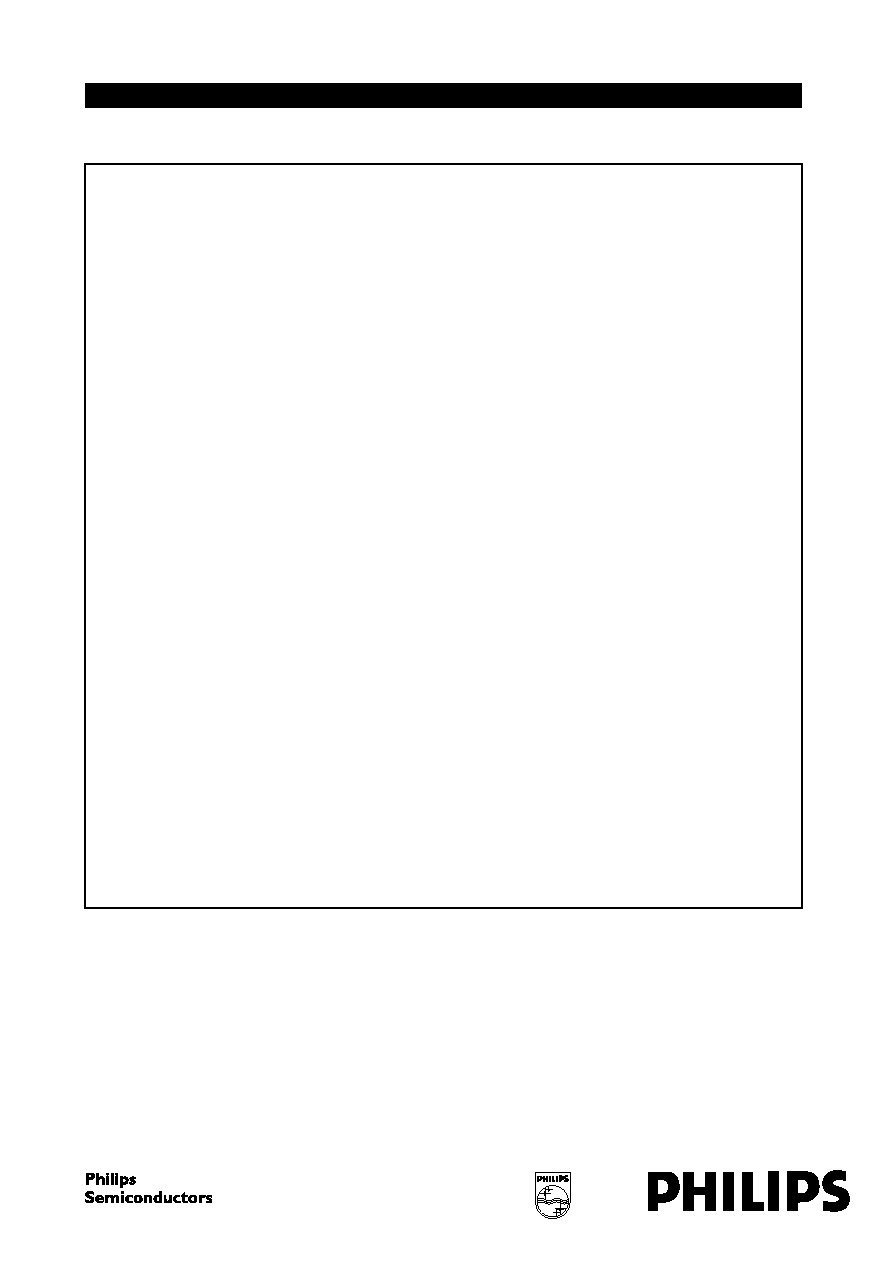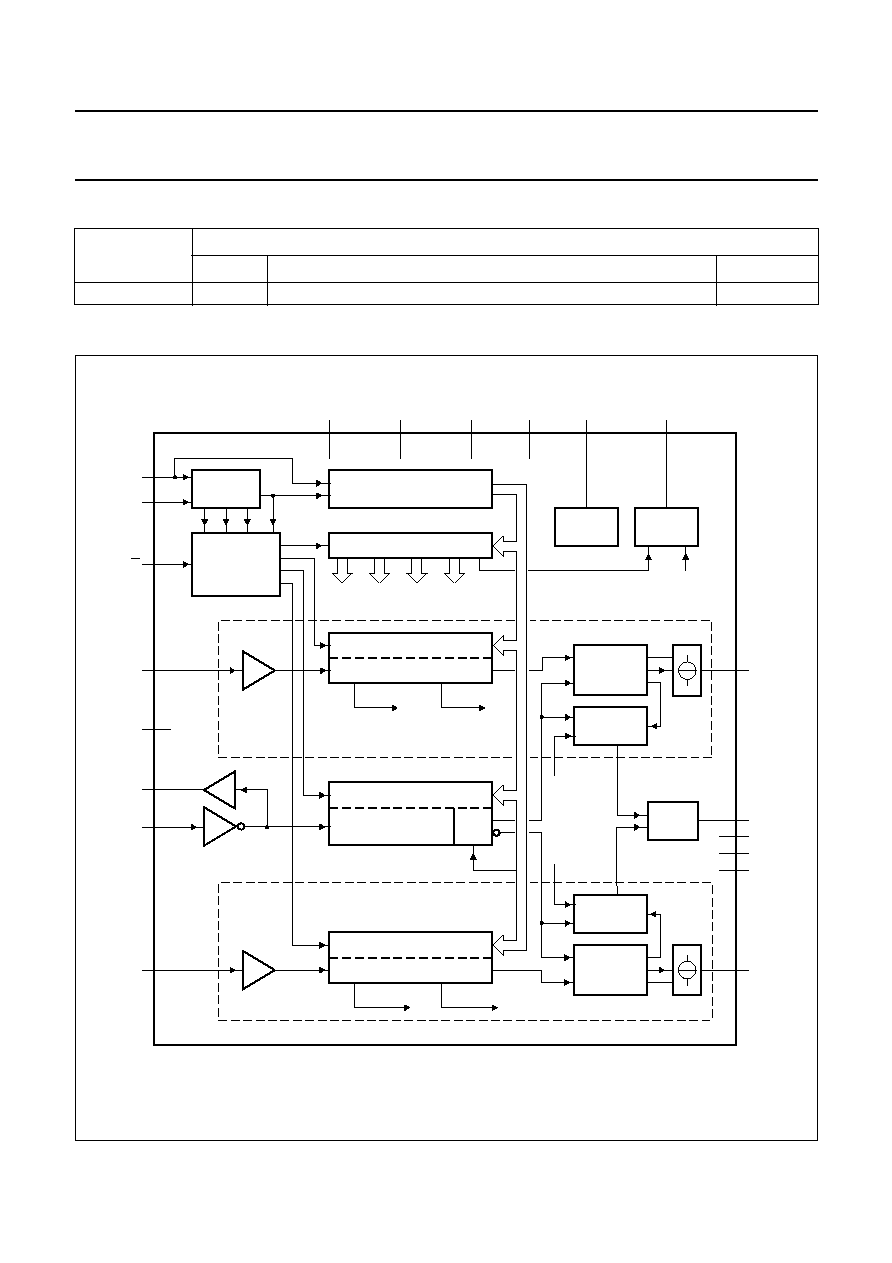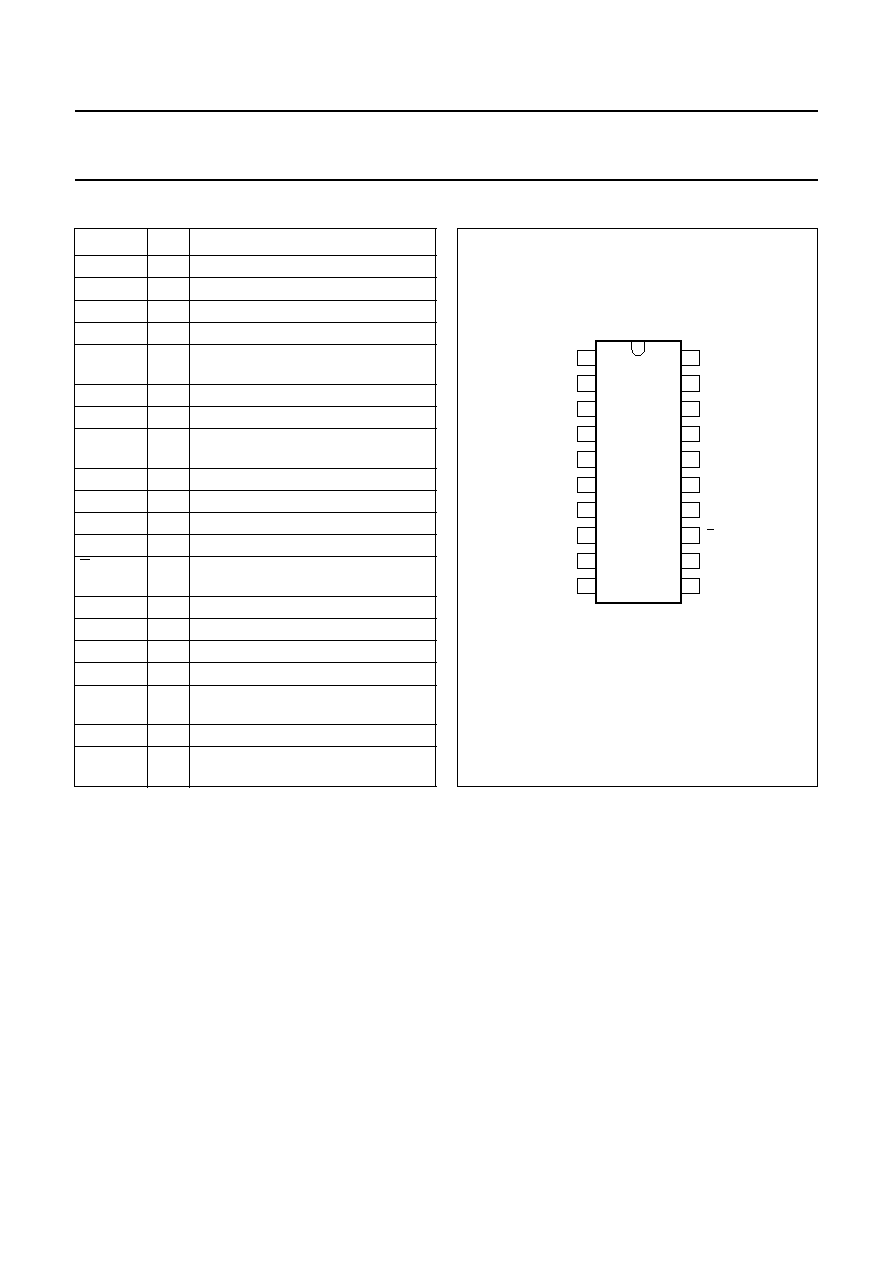Low-power dual frequency synthesizer for radio communications

DATA SHEET
Product specification
Supersedes data of 1997 Jun 10
File under Integrated Circuits, IC17
1997 Sep 03
INTEGRATED CIRCUITS
UMA1015AM
Low-power dual frequency
synthesizer for radio
communications

1997 Sep 03
2
Philips Semiconductors
Product specification
Low-power dual frequency synthesizer
for radio communications
UMA1015AM
FEATURES
·
Two fully programmable RF dividers up to 1.1 GHz
·
Fully programmable reference divider up to 35 MHz
·
2 : 1 or 1 : 1 ratio of selectable reference frequencies
·
Fast three-line serial bus interface
·
Adjustable phase comparator gain
·
Programmable out-of-lock indication for both loops
·
On-chip voltage doubler
·
Low current consumption from 3 V supply
·
Separate power-down mode for each synthesizer
·
Up to 4 open-drain output ports
·
Crystal input frequency signal inverted and buffered
output on separate pin.
APPLICATIONS
·
Cordless telephone
·
Hand-held mobile radio.
GENERAL DESCRIPTION
The UMA1015AM is a low-power dual frequency
synthesizer for radio communications which operates in
the 50 to 1100 MHz frequency range. Each synthesizer
consists of a fully programmable main divider, a phase and
frequency detector and a charge pump. There is a fully
programmable reference divider common to both
synthesizers which operates up to 35 MHz.
The device is programmed via a 3-wire serial bus which
operates up to 10 MHz. The charge pump currents (gains)
are fixed by an external resistance at pin 20 (I
SET
).
The BiCMOS device is designed to operate from 2.7 V
(3 NiCd cells) to 5.5 V at low current. Digital supplies V
DD1
and V
DD2
must be at the same potential. The charge pump
supply (V
CC
) can be provided by an external source or
on-chip voltage doubler. V
CC
must be equal to or higher
than V
DD1
.
Each synthesizer can be powered-down independently via
the serial bus to save current. It is also possible to
power-down the device via the HPD input (pin 5).
QUICK REFERENCE DATA
SYMBOL
PARAMETER
CONDITIONS
MIN.
TYP.
MAX.
UNIT
V
DD1
, V
DD2
digital supply voltage
V
DD1
= V
DD2
2.7
-
5.5
V
V
CC
charge pump supply voltage
external supply; doubler
disabled; V
CC
V
DD
2.7
-
6.0
V
V
CCvd
charge pump supply from
voltage doubler
doubler enabled
-
2V
DD1
-
0.6 6.0
V
I
DD1
+ I
DD2
+ I
CC
operating supply current
both synthesizers ON; doubler
disabled; V
DD1
= V
DD2
= 3 V
-
8.7
-
mA
I
DDpd
+ I
CCpd
total current in power-down
mode
doubler disabled;
V
DD1
= V
DD2
= 3 V
-
3
-
µ
A
I
DDpd
current in power-down mode
from supply V
DD1
and V
DD2
doubler enabled;
V
DD1
= V
DD2
= 3 V
-
0.25
-
mA
f
RF
RF input frequency for each
synthesizer
50
-
1100
MHz
f
XTALIN
crystal input frequency
3
-
35
MHz
f
pc(min)
minimum phase comparator
frequency
-
10
-
kHz
f
pc(max)
maximum phase
comparator frequency
-
750
-
kHz
T
amb
operating ambient
temperature
-
30
-
+85
°
C

1997 Sep 03
3
Philips Semiconductors
Product specification
Low-power dual frequency synthesizer
for radio communications
UMA1015AM
ORDERING INFORMATION
BLOCK DIAGRAM
TYPE NUMBER
PACKAGE
NAME
DESCRIPTION
VERSION
UMA1015AM
SSOP20
plastic shrink small outline package; 20 leads; body width 4.4 mm
SOT266-1
Fig.1 Block diagram.
handbook, full pagewidth
MGG523
4-BIT SHIFT
REGISTER
CONTROL LATCH
power
down
OOL
select
current
ratio
port
bits
17-BIT SHIFT REGISTER
LATCH
MAIN DIVIDER
TOOL A
RFA/64
LATCH
MAIN DIVIDER
TOOL B
RFB/64
LATCH
REFERENCE DIVIDER
DIV
BY 2
ADDRESS
DECODER
PHASE
DETECTOR
LOCK
DETECTOR
PHASE
DETECTOR
LOCK
DETECTOR
LOCK
SELECT
TOOL A
TOOL B
PUMP
BIAS
VOLTAGE
DOUBLER
SR
SYNTHESIZER A
SYNTHESIZER B
11
12
13
6
5
10
8
15
4
14
7
16
20
18
3
19
1
2
9
17
CLK
DATA
E
RFA
HPD
fXTALO
fXTALIN
RFB
VDD1
VDD2
DGND
AGND
ISET
VCC
CPA
P0/OOL
P1
P2
P3
CPB
VDB enable
RF/64
phase
error
phase
error
UMA1015AM

1997 Sep 03
4
Philips Semiconductors
Product specification
Low-power dual frequency synthesizer
for radio communications
UMA1015AM
PINNING
SYMBOL
PIN
DESCRIPTION
P1
1
output Port 1
P2
2
output Port 2
CPA
3
charge pump output synthesizer A
V
DD1
4
digital supply voltage 1
HPD
5
hardware power-down
(input LOW = power-down)
RFA
6
RF input synthesizer A
DGND
7
digital ground
f
XTALIN
8
common crystal frequency input from
TCXO
P3
9
output Port 3
f
XTALO
10
open-drain output of f
XTAL
signal
CLK
11
programming bus clock input
DATA
12
programming bus data input
E
13
programming bus enable input
(active LOW)
V
DD2
14
digital supply voltage 2
RFB
15
RF input synthesizer B
AGND
16
analog ground to charge pumps
CPB
17
charge pump output synthesizer B
V
CC
18
analog supply to charge pump;
external or voltage doubler output
P0/OOL
19
Port output 0/out-of-lock output
I
SET
20
regulator pin to set charge pump
currents
Fig.2 Pin configuration.
handbook, halfpage
P1
P2
CPA
VDD1
HPD
RFA
DGND
fXTALIN
P3
fXTALO
ISET
P0/OOL
VCC
CPB
RFB
VDD2
AGND
E
DATA
CLK
1
2
3
4
5
6
7
8
9
10
11
12
20
19
18
17
16
15
14
13
UMA1015AM
MGG522
FUNCTIONAL DESCRIPTION
Main dividers
Each synthesizer has a fully programmable 17-bit main
divider. The RF input drives a pre-amplifier to provide the
clock to the first divider bit. The pre-amplifier has a high
input impedance, dominated by pin and pad capacitance.
The circuit operates with signal levels from below
50 mV (RMS) up to 250 mV (RMS), and at frequencies up
to 1.1 GHz. The high frequency sections of the divider are
implemented using bipolar transistors, while the slower
section uses CMOS technology. The range of division
ratios is 512 to 131071.
Reference divider
There is a common fully programmable 12-bit reference
divider for the two synthesizers. The input f
XTALIN
drives a
pre-amplifier to provide the clock input for the reference
divider. This clock signal is also inverted and output on pin
f
XTALO
(open drain). A crystal connected between f
XTALIN
and f
XTALO
with suitable feedback components can be
used to make an oscillator. An extra divide-by-2 block
allows a reference comparison frequency for
synthesizer B to be half the frequency of synthesizer A.
This feature is selectable using the program bit SR. If the
programmed reference divider ratio is R then the ratio for
each synthesizer is as given in Table 1.
The range for the division ratio R is 8 to 4095. Opposite
edges of the divider output are used to drive the phase
detectors to ensure that active edges arrive at the phase
detectors of each synthesizer at different times. This
minimizes the potential for interference between the
charge pumps of each loop. The reference divider consists
of CMOS devices operating beyond 35 MHz.

1997 Sep 03
5
Philips Semiconductors
Product specification
Low-power dual frequency synthesizer
for radio communications
UMA1015AM
Table 1
Synthesizer ratio of reference divider
Phase comparators
For each synthesizer, the outputs of the main and
reference dividers drive a phase comparator where a
charge pump produces phase error current pulses for
integration in an external loop filter. The charge pump
current is set by an external resistance R
SET
at pin I
SET
,
where a temperature-independent voltage of 1.1 V is
generated. R
SET
should be between 12 and 60 k
.
The charge pump current, I
CP
, can be programmed to be
either (12
×
I
SET
) or (24
×
I
SET
) with a maximum of 2.3 mA.
The dead zone, caused by finite switching of current
pulses, is cancelled by an internal delay in the phase
detector thus giving improved linearity. The charge pump
has a separate supply, V
CC
, which helps to reduce the
interference on the charge pump output from other parts of
the circuit. V
CC
can be higher than V
DD1
if a wider range on
the VCO input is required. V
CC
must not be less than V
DD1
.
Voltage doubler
If required, there is a voltage doubler on-chip to supply the
charge pumps at a higher level than the nominal available
supply. The doubler operates from the digital supply V
DD1
,
and is internally limited to a maximum output of 6 V.
An external capacitor is required on pin V
CC
for smoothing,
the capacitor required to develop the extra voltage is
integrated on-chip. To minimize the noise being introduced
to the charge pump output from the voltage doubler, the
doubler clock is suppressed (provided both loops are
in-lock) for the short time that the charge pumps are active.
The doubler clock (RF/64) is derived from whichever main
divider is operating (synthesizer A has priority). While both
synthesizers are powered down (and the doubler is
enabled), the doubler clock is supplied by a low-current
internal oscillator. The doubler can be disabled by
programming the bit VDON to logic 0, in order to allow an
external charge pump supply to be used.
Out-of-lock indication/output ports
There is a common lock detector on-chip for the
synthesizers. The lock condition of each, or both loops, is
output via an open-drain transistor which drives
pin P0/OOL (when out-of-lock, the transistor is turned on
and therefore the output is forced LOW). The lock
condition output is software selectable (see Table 4).
SR
SYNTHESIZER A
SYNTHESIZER B
0
R
R
1
R
2R
An out-of-lock condition is flagged when the phase error is
greater than T
OOL
, which is approximately 30 ns.
The out-of-lock flag is only released after the first reference
cycle where the phase error is less than T
OOL
.
The out-of-lock function can be disabled, via the serial bus,
and the pin P0/OOL can be used as a port output. Three
other port outputs P1, P2 and P3 (open-drain transistors)
are also available.
Serial programming bus
A simple 3-line unidirectional serial bus is used to program
the circuit. The 3 lines are DATA, CLK and E (enable).
The data sent to the device is loaded in bursts framed
by E. Programming clock edges are ignored until E goes
active LOW. The programmed information is loaded into
the addressed latch when E returns inactive (HIGH). This
is allowed when CLK is in either state without causing any
consequences to the register data. Only the last 21 bits
serially clocked into the device are retained within the
programming register. Additional leading bits are ignored,
and no check is made on the number of clock pulses.
The fully static CMOS design uses virtually no current
when the bus is inactive. It can always capture new
programming data even during power-down of both
synthesizers.
However when either synthesizer A or synthesizer B or
both are powered-on, the presence of a TCXO signal is
required at pin 8 (f
XTALIN
) for correct programming.
Data format
Data is entered with the most significant bit first.
The leading bits make up the data field, while the trailing
four bits are an address field. The address bits are
decoded on the rising edge of E. This produces an internal
load pulse to store the data in the addressed latch.
To ensure that data is correctly loaded on first power-up,
E should be held LOW and only taken HIGH after having
programmed an appropriate register. To avoid erroneous
divider ratios, the pulse is inhibited during the period when
data is read by the frequency dividers. This condition is
guaranteed by respecting a minimum E pulse width after
data transfer. The data format and register bit allocations
are shown in Table 2.
Document Outline
- FEATURES
- APPLICATIONS
- GENERAL DESCRIPTION
- QUICK REFERENCE DATA
- ORDERING INFORMATION
- BLOCK DIAGRAM
- PINNING
- FUNCTIONAL DESCRIPTION
- Main dividers
- Reference divider
- Phase comparators
- Voltage doubler
- Out-of-lock indication/output ports
- Serial programming bus
- Data format
- Power-down modes
- LIMITING VALUES
- HANDLING
- CHARACTERISTICS
- SERIAL TIMING CHARACTERISTICS
- TYPICAL PERFORMANCE CHARACTERISTICS
- APPLICATION INFORMATION
- PACKAGE OUTLINE
- SOLDERING
- DEFINITIONS
- LIFE SUPPORT APPLICATIONS




